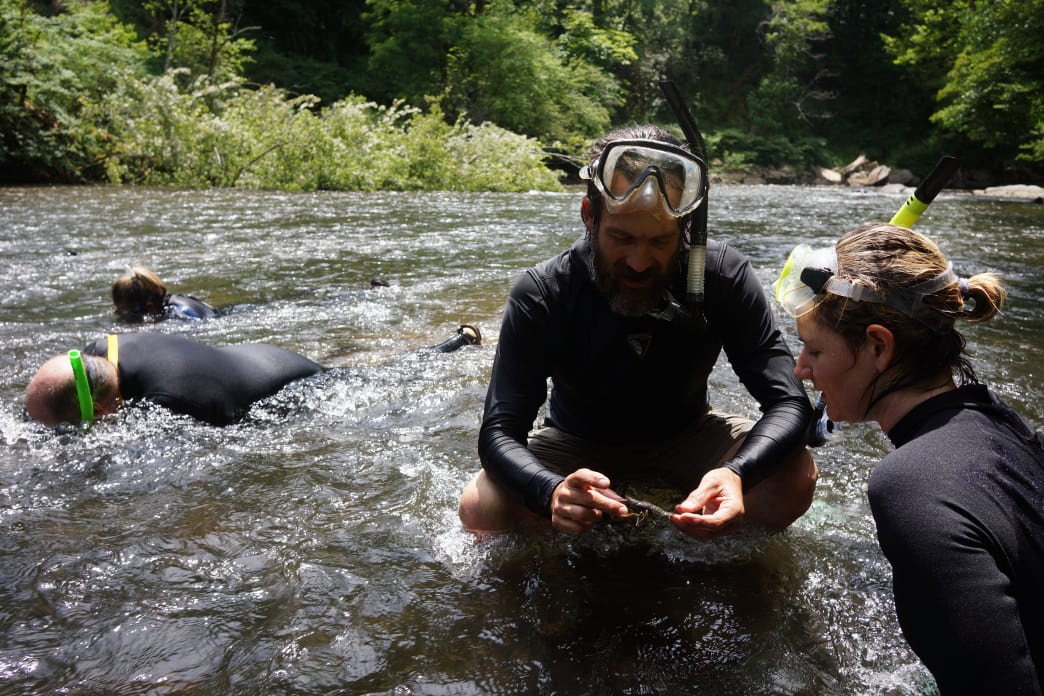If you visit one of Cherokee National Forest’s many rivers or streams this summer you might encounter an unusual sight: people donning wetsuits, personal flotation devices, and… snorkels? No, you’re not seeing things—in recent years, the Southeastern forest has become a destination for those seeking out fish and other underwater species because of its cool, clear waters, undisturbed nature, and extraordinary aquatic diversity.
The Cherokee National Forest itself is enormous. Spanning more than 650,000 acres, it makes up nearly the entire eastern border of Tennessee and is the state’s largest tract of public land. The forest’s 14 different recreation zones offer up some 600-plus miles of hiking trails, including portions of the Appalachian Trail, the Benton MacKaye Trail, and the John Muir National Recreation Trail. Paddlers can test their skills on the world-renowned rapids of the Ocoee, the Hiwassee, and the Tellico, while mountain bikers can tear up the singletrack in the Chilhowee Recreation Area. Options for camping and exciting outdoor activities abound, and frankly, you’d be hard-pressed to run out of things to do and places to see inside the sprawling boundaries of the Cherokee National Forest.
Bring Your Snorkel!

U.S Fish and Wildlife Service Southeast Region
While you could easily spend years unlocking the many secrets of Cherokee, there’s no better way to get started than by spending a warm weekend snorkeling its crystal waters and camping under the summer sky.
Just about any of the forest’s streams and rivers have prime snorkeling spots with clear water and abundant aquatic wildlife, but some classic destinations are the Conasauga River, Citico Creek, and the Hiwassee River (when it isn’t running). Outfitters host guided snorkeling trips on all three of these rivers, but you can always go out on your own, too.
On any given day, you could see up to 20 different species in the water, including freshwater drum, bream, tadpoles, turtles, salamanders, mussels, snails, and more. As many as 45 species have been documented in a single area, so you’re pretty much guaranteed to find a fascinating array of freshwater friends.
Cherokee National Forest is home to some seriously impressive diversity. The Conasauga River and Citico Creek Watersheds each host about 70 different aquatic species, compared to the much larger Columbia and Colorado River Watersheds in the West, which have only about 30 species each. A summer day may draw thousands of fish to a single pool here.
If you aren’t quite ready to go out on your own (or you don’t have your own gear), sign up for a guided trip through the Ocoee Whitewater Center and you’ll get everything you need, as well as the leadership of a knowledgeable guide and a lifeguard. These trips are for 12 to 25 people, ages 12 and up, and cost around $25 per person. During the 4-hour program, you’ll receive instruction and firsthand information about aquatic wildlife, as well as assistance in identifying fish and their habitats. Reservations are ideal for large groups.

U.S Fish and Wildlife Service Southeast Region
Personal trips are also a great way to get to know the underwater happenings of the national forest and give you the freedom to move around and spend as much or little time as you want in the water. However you decide to explore, spending a day (or a week) getting up close with the rivers’ aquatic animals will open your goggled eyes to a whole new world within the Cherokee National Forest.
Stay the Night
After your aquatic adventure, plan to pitch your tent or park your camper in one of the national forest’s various campsites. The options range from full-hookup RV campgrounds to secluded pack it in/pack it out sites in the backcountry.
The forest has more than 30 developed campgrounds with varying amenities. Most have at least a fire ring, table, and lantern post, though some have more extensive offerings such as potable water, toilets, and showers. Campground sites are first come, first served, and just about all of them are large and flat enough to accommodate a tent or camper. A rundown of every formal campground can be found on the Forest Service’s website.
If you are looking for a more isolated experience, dispersed camping is permitted throughout Cherokee National Forest, unless otherwise posted. No fee or permit is required, though there are some regulations regarding distance from trailheads, parking lots, etc. Since there is little official information about dispersed camping in the national forest online, finding your perfect “primitive” site can be a game of chance. Don’t be afraid to wander off the beaten path (or down the little-used gravel road) in search of a hidden gem. If you opt for this grittier version of camping, remember to follow Leave No Trace principles to preserve the integrity of the national forest.

U.S Fish and Wildlife Service Southeast Region
Whether you incorporate your snorkeling trip into a luxurious RV stay or a backcountry experience, it’s easy to mix and match to create your perfect summer adventure in the Cherokee National Forest. So grab your snorkel and gear up for a fantastic and fascinating time getting to know the aquatic communities that thrive under the flowing waters of Cherokee National Forest.
Written by Madison Eubanks for RootsRated in partnership with BCBS of Tennessee.
Featured image provided by U.S Fish and Wildlife Service Southeast Region
Get more information about specific health terms, topics and conditions to better manage your health on bcbst.com. BlueCross BlueShield of Tennessee members can access wellness-related discounts on fitness products, gym memberships, healthy eating and more through Blue365®. BCBST members can also find tools and resources to help improve health and well-being by logging into BlueAccess and going to the Managing Your Health tab.



WellTuned provides inspiration and practical advice for healthy living.
WellTuned does not offer medical advice. Any personal health questions should be addressed to your doctor.